By Rachael Finch, Senior Director of Preservation and Education
A rainstorm did not deter an enthusiastic audience from gathering at the Williamson County Enrichment Center in Franklin, Tennessee to attend the Heritage Foundation’s 4th Annual Symposium, Revitalizing Preservation: See History, See Potential on August 21, 2021.
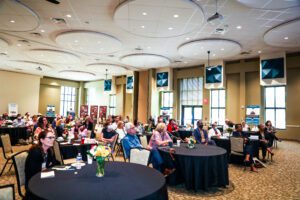
photography by Daniel C. White
Sponsored by the Harpeth Hotel and Twine Graphics, this year’s symposium featured speakers from the African American Cultural Heritage Action Fund at the National Trust for Historic Preservation and the Preservation Resource Center in New Orleans, who discussed best practices in inclusive preservation, equity of our historic places and spaces as well as issues regarding elevating historic preservation practices to positively impact our communities.
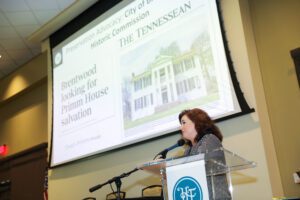
photography by Daniel C. White
The symposium opened with a warm welcome and reflection on the symposium’s history by President & CEO Bari Beasley, noting the Heritage Foundation’s commitment to history education, community outreach, and practical applications for preservation in our county. Senior Director of Preservation & Education Rachael Finch introduced the keynote speakers and was a part of a panel discussion on revitalizing relevancy in preservation at the local level.
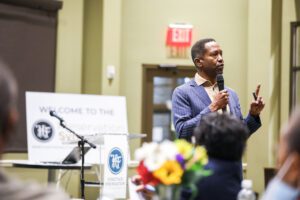
Keynote speaker, Brent Leggs (photography by Daniel C. White)
In his keynote session, “Building An Inclusive National Identity,” Brent Leggs, Executive Director of the African American Cultural Action Fund for the National Trust for Historic Preservation, simply yet emphatically stated, “preservation is transcendent.” Leggs shared how preservation impacted his own life; his first foray into historic preservation was to inventory all Rosenwald schools in his home state of Kentucky. “For me, it became personal when I learned my mom and dad attend Rosenwald schools…as I stood inside of these schools, I could hear the voices…see and smell the decay to make the connection that preservation removes the gap between space and time. To stand in these spaces and recognize Julius Rosenwald and Booker T. Washington’s collective vision of uplifting Black America through this social movement still lives on through the power of place.”
Leggs shared that the goal of the African American Cultural Heritage Action Fund is preservation activism. Used as a tool for equity and justice, preservation as activism redefines a new cultural narrative. It shifts the scripts from seeing African Americans as spectators from the past to recognizing African Americans as vital actors who played a significant role in shaping the historical narrative beyond suffering and marginalization. Leggs highlighted multiple stories from across the country, concentrated on narratives of freedom, education, courage, and entrepreneurship, and commemorating a new civil rights cultural legacy. Leggs ended with a call to action. “As a nation, we are deciding on how we tell the full American story. What stories must be told, and what sites must be preserved to serve a more just and equitable society?”
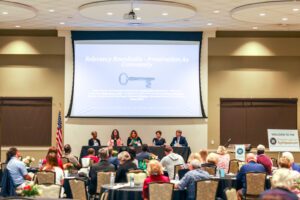
Roundtable Session (photography by Daniel C. White)
The mid-morning roundtable session discussed the relevancy of preservation at the local level. Panelists included the Heritage Foundation’s preservation team and Brentwood Historic Commission members. Each panelist shared their own preservation stories. The evolution of relevancy in preservation – whether by intent or by accident – illustrated how their career paths in preservation, advocacy, and community outreach continue to impact how they view the local preservation movement. The roundtable sparked a lively audience discussion on how best to activate our community to engage with preservation.
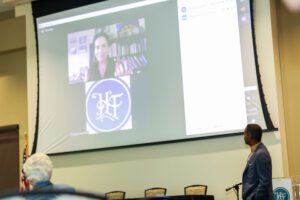
keynote speaker Danielle Del Sol (photography by Daniel C. White)
In our afternoon session, “Reviving Relevance: Improving Historic Preservation’s Impact on Our Communities,” Executive Director of the Preservation Resource Center in New Orleans, Danielle De Sol, discussed actions that can be taken to make historic places, particularly neighborhoods, more relevant and resilient against demolition, condemnation, and climate concerns. De Sol emphasized that through clear communication, education, advocacy, and reliable funding sources meaningful preservation is possible. Posing the question, “Why should people care?” De Sol shared the economic impact and practical approaches for local communities to gain a foothold by preserving buildings, homes, neighborhoods, and parks stating, “there are many places to save, if there is a will to save them.” This is where the Preservation Resource Center stands out as a leader in grassroots advocacy. Utilizing their Revival Grants and Revolving Fund, Preservation Resource Center affords property owners the chance to remain in their homes while also preserving historic neighborhoods. Residents, like architecture, history, and cultural heritage, are significant components of retaining a city’s unique character. In doing so, the community retains relevancy.
The symposium ended with the presentation of our preservation awards. In addition to speaking directly with our symposium’s speakers during an afternoon Q & A, attendees had an opportunity to tour Franklin Grove Estate & Gardens and learn the property’s fascinating history.
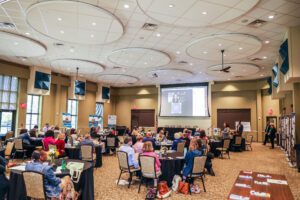
photography by Daniel C. White
The symposium drew nearly ninety attendees, comprised of local citizens, owners of historic properties, architects, archaeologists, architectural historians, graduate students, state preservationists and commissioners, museum educators, historical societies, and educational institutions. The content was focused. The excitement and energy palpable. As I personally reflect back on the symposium, these words remain central in my mind. Revitalization. Relevancy. Identity. Inclusion. Preservation. Community. I encourage our members to begin a dialogue amongst your neighbors, friends, colleagues, (and yes, even with us!) on how we may be intentional as local citizen preservationists to better our community, seek relevancy through the revitalization of place, and celebrate the stories of our collective heritage.